
Big cat crossing sign at the Bronx Zoo 😸

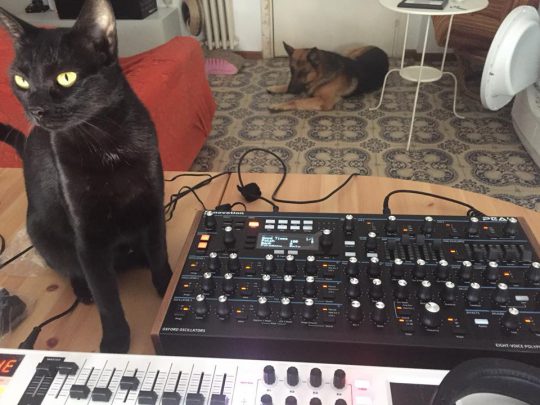
We always love seeing black cats, especially color-coordinated with their musical instruments. Here we see a beautiful black cat posing with a Novation Peak synthesizer.
By Enzo Di Michele from a thread in the Facebook group Synthesizer Freaks. Yes, the same thread that featured yesterday’s picture 😺
NAMM is full of serendipitous moments. One of those occurred as we passed the WMD booth and saw a live performance unfolding with flute and woodwind virtuoso Pedro Eustache performing on a vintage wind instrument controlling a WMD Synchrodyne module. We featured it on CatSynth TV.
Eustache informed us that his wind instrument was an unusual one from the 1970s, and that he was using it as a CV controller for the Synchrodyne. He found the combination to be quite expressive and complete, and we can certainly hear that in his performance.
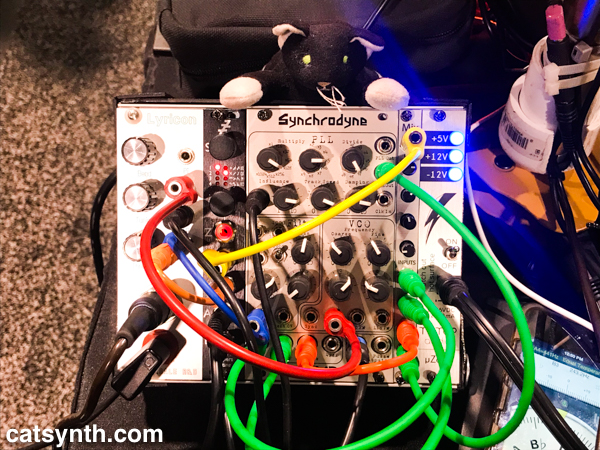
The Synchrodyne is intended to be a complete synthesizer voice in a module, and it has the combination of sawtooth VCO, filter, and VCA that are the building blocks of subtractive synthesis. But it also includes a built-in Phase-Locked Loop (PLL) controlling the VCO, which adds a variety of new sound and control dimensions. PLLs can be challenging to use – the concept implies stability but often includes chaotic phases – but controls on the PLL for dampening, speed and input influence provide more musical control. Additionally, the VCO provides support for frequency modulation. Finally, there is a wavefolder on the front end of the filter that provides additional non-linear signal processing and distortion options. WMD puts it succinctly in their description of the module:
Containing several pieces to a traditional synthesizer voice, the Synchrodyne is a powerful addition to any subtractive oriented system. However, it is designed primarily as an experimental sound source/filter, intended to push the limits of modular synthesis…WMD style.
This is not your classic subtractive analog synthesizer voice, as one might find in a Moog synthesizer or the Korg Prologue that we reviewed in an earlier article. It is a beast, but with practice, we see how it can be an expressive musical instrument on its own. We look forward to trying it out ourselves one of these days. And we thank Pedro Eustace for being so gracious after the performance and sharing with us his process making music with the Synchrodyne and his wind controller. From his official website:
“In Pedro’s own words: ‘I simply hope–and I really work hard at this, through ‘active submission’–that someday, whenever I see my Creator I would be able to give Him an answer worthy of the ‘package-of- grace’ he entrusted me with.'”
We would be remiss if we didn’t visit the Korg booth at NAMM, especially as Waldorf was there as well. We took some quick peeks at some of the new offerings, which you can see in this video.
The Korg Prologue synthesizer was among the most hyped instruments leading up to NAMM, so we of course had to check it out.
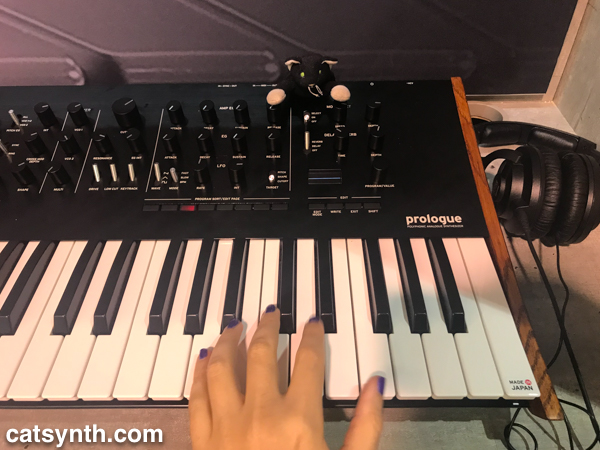
It is quite pretty, with a sleek black front panel and wooden side panels. The analog synth was not that exciting to us, as we at CatSynth are rather spoiled by the offerings of Dave Smith Instruments such as the Rev2 or Prophet 6. And it doesn’t fill the niche of the Minilogue as an affordable polyphonic analog synthesizer. What intrigues us is the open architecture for the digital oscillators that will allow advanced users to add their own programs. At NAMM, it is difficult to impossible to explore this, but we look forward to learning more about in the future.

By contrast, the Waldorf STVC string synthesizer and vocoder was fun to play and sounded great on our first test. The vocoder played more smoothly with my voice than the Roland VP-03 that I frequently use (including in the opening for CatSynth TV). But it does require dialing in the exact right patch for one’s voice. When we returned to the booth to record our video segment, it took a while to find something that worked, and it wasn’t quite as good as that first time. But we know this is part of the deal with vocoders, and they require practice to play well.

We visited our friends at Rossum Electro-Music at NAMM and were treated to an in-depth demonstration of their Assimil8or module by Marco Alpert.
We are grateful to Marco for his demonstration, not just because it made our video awesome, but because it helped better understand what is a complex module. The Assimil8or is a sample engine with many of the features one found in classic E-MU samplers, and more (Dave Rossum being the mastermind behind E-MU’s popular instruments). One particularly intriguing advance was the timed switching among samples, which allows one to move between different tracks seamlessly while remaining in time (the Cars example in the video demonstrates this quite well). There is also “virtual tape-scrubbing” of audio. Of course, everything is CV controllable.
Combining the Assimil8or with the Morpheus module (which we at CatSynth own and enjoy) and the Control Forge, one can assemble something akin to an E-MU sampler on steroids, with vastly more complex and rich control options, including at audio rate! Even the Morpheus on its own is rather overwhelming, but having seen the modules in action by the folks who made gives us ideas on how to use it better. We look forward to more experiments with these modules from Rossum Electro-Music!
More info can be found at http://www.rossum-electro.com.
(Disclosure: Amanda Chaudhary of CatSynth used to work for E-MU Systems, several of whose principals are now at Rossum Electro-Music.)
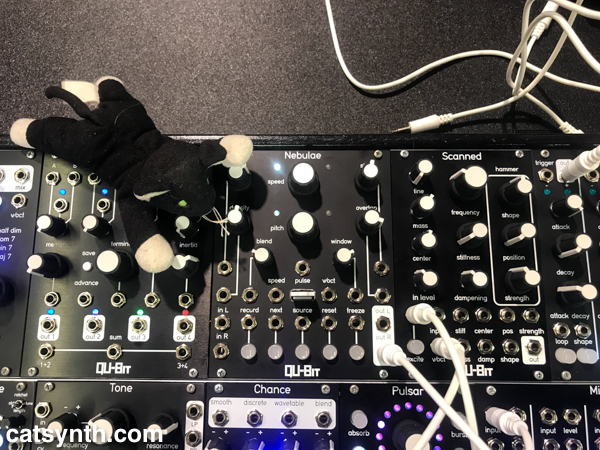
One of our first stops at NAMM 2018 was to visit our friends at Qu-Bit Electronix to see what they are up to. They have three new modules, Synapse, Nebulae MK2, and Scanned. We had a chance to try them out for ourselves – you can see a bit of our experience in this video.
We at CatSynth own and enjoy using the original Nebulae module, but the MK2 is a significant improvement, with more versatile and expressive controls for pitch, speed, and granularity (rate, window, etc.). The main speed button traverses quite a range both forward and backward, and features a quick reset to unity by pressing. Similar functionality is available with the pitch button. The granularity features go beyond the original, including the ability to freeze the sound in place to create a steady timbre from any section of a recording.
The Scanned module is perhaps the first hardware implementation of scanned synthesis technique pioneered by Max Matthews and others. The simplest way to describe it is as a system that provides the control of a struck or plucked string, but with a far greater range of sound than a vibrating string, such as any wavetable source. The module has independent controls for pluck, tension, and many more parameters, of course all individually controlled via CV. With pitch and gate input, it becomes the starting block for a rich modular instrument.
Although not included in the video demo, the Synapse is an interesting and handy module for mixing, switching, and otherwise routing a variety of CV sources to various destinations all from a single module. It makes your CV sources more like a mixer with cross-fades and such.
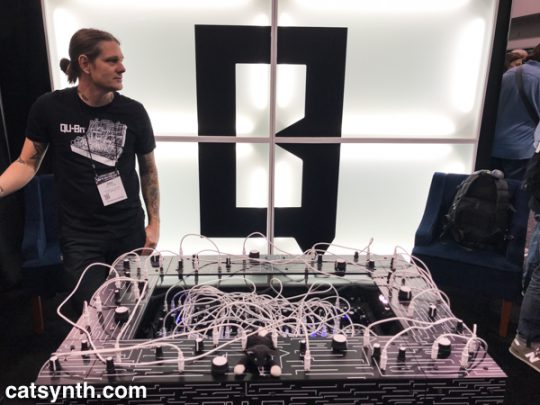
It’s always fun to check in with Qu-Bit, and we look forward to seeing more of these modules.
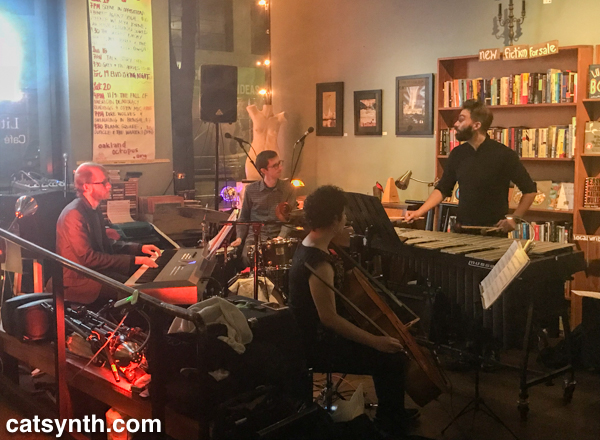
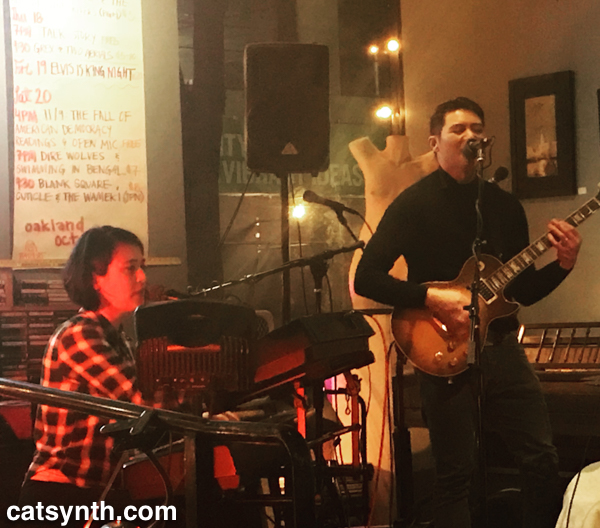

Pretty picture of a tuxedo cat that bears a strong resemblance to Sam Sam (minus the nose smudge) with a classic Roland SH-101 synthesizer. From verzerrung on Instagram.
Sam Sam does not have access to an SH-101, but she does seem to like the Roland Boutique synths, so maybe we will get an SH-01 for her at some point 😸
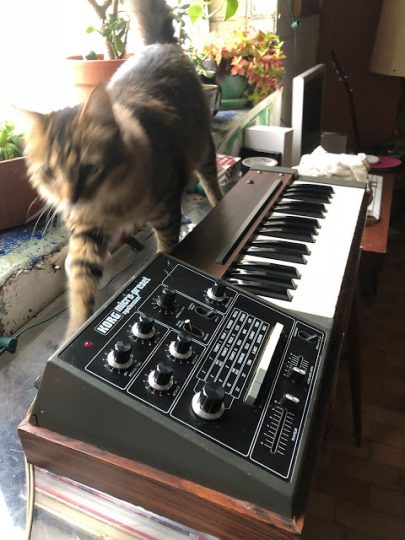
Originally rom a now completed listen on Reverb.com, today’s pic arrives via matrixsynth, where you can see more pictures (sans cat).
The Korg Micro Preset synthesizer is a curious late 1970s beast with a slightly bizarre matrix of pre-set sounds, including woodwind and similar noises and a keyboard all housed in a wooden box! It’s a 32-note monophonic preset synthesizer with 6 push-button presets including voice, synth1, synth2, brass, string, and wood. Its single-oscillator design has only rudimentary decay/release envelope controls and no access to the guts of the sound generation stuff.
Once you’re past the outward appearance, a bit of probing will reveal a noise box that sounds remarkably similar to the MS-10 at times. There is a lot of fun to be had with the ‘traveller’ control, a sort of filter and resonance control rolled into one, offering interesting squelchy acid-style bass run effects. In fact, like the MS-10, bass is the best of what you get out of this guy along with lots of other useful noises. Add N To (X), The Human League, OMD, Jean Michel Jarre, OMD, Pop Will Eat Itself and Brian Eno are thought to have used the Micro Preset.
A few of the presets are slightly quieter. Easily addressed by turning the volume up. Since this Keyboard was only ever used in our smoke free studio, we never had a tech fix it. Our tech HAD seen this issue before and did say the fix would take 1hr and require minimal parts he, and thusly most techs, should have. This thing sounds amazing straight into a delay pedal and then a DI. Only selling it because we loved it so much we bought 2 but need only one. It’s killer for when you want a simple MS-10/20 sound but don’t want to fuss about. It’s been on a ton of records made here. Great and affordable addition to any collection and would be a great first synth.”